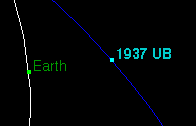
Using sophisticated orbit determination tools, the difficult problem of finding a precise orbit for the long-lost and recently rediscovered asteroid Hermes has been solved.
The recovery of Hermes was announced on October 15, 2003 by the Minor Planet Center (MPC) in Cambridge Massachusetts. The object was initially noted by Brian Skiff of the LONEOS asteroid search program at the Lowell Observatory in Arizona, and key follow-up measurements were provided by James Young of JPL’s Table Mountain Observatory in California. Tim Spahr of the MPC located prediscovery observations from the last 7 weeks and computed the new object’s orbit. Noticing that the orbit was very similar to that of Hermes, last seen during its close approach in 1937, Spahr concluded that the new object was almost certainly Hermes. Definitive proof of the object’s identity was still lacking, however, because an orbit linking the known positions in 1937 to those in 2003 could not be found.
Finding the precise orbit of Hermes is difficult because its trajectory is very chaotic. In the 66 years since it was last seen, the asteroid has made numerous close approaches to both the Earth and Venus. Since the orbital changes at each approach depend highly on the circumstances of the encounter, finding an orbit with the precise sequence of encounter conditions that links positions in 2003 to those in 1937 is a challenging problem in orbit determination.
We have now solved this problem by using the JPL Sentry impact monitoring software in a novel way. Starting from the 2003 positions, Sentry found twelve distinct dynamical pathways that produced encounters in 1937, each with a different sequence of intervening close approach circumstances. Comparing these predicted 1937 encounters with the one determined directly from the 1937 observations, we were able to identify the most consistent candidate, and then zero in on the precise orbit that best matches the positions in both 1937 and 2003. We now know that since it was last seen, Hermes has made eight close approaches to the Earth and Venus to within 0.06 AU, including an Earth approach to within about 1.6 lunar distances in 1942. The new orbit solution allows us to predict future close approaches with great accuracy; we can now predict that Hermes will not approach the Earth any closer than about 0.02 AU (8 lunar distances) within the next hundred years.